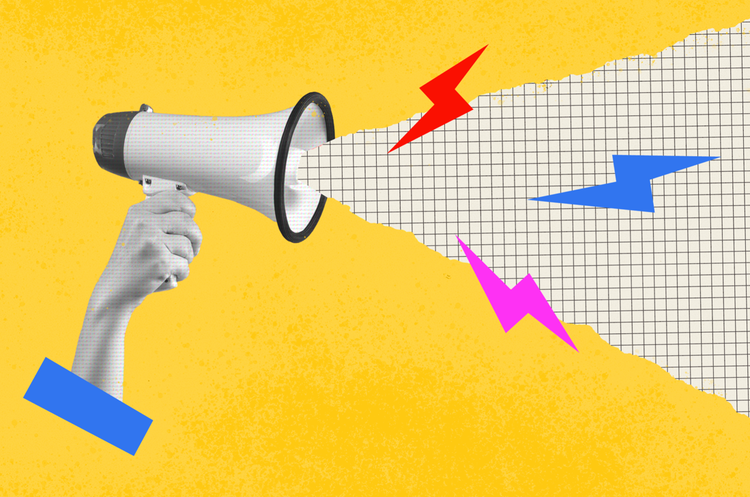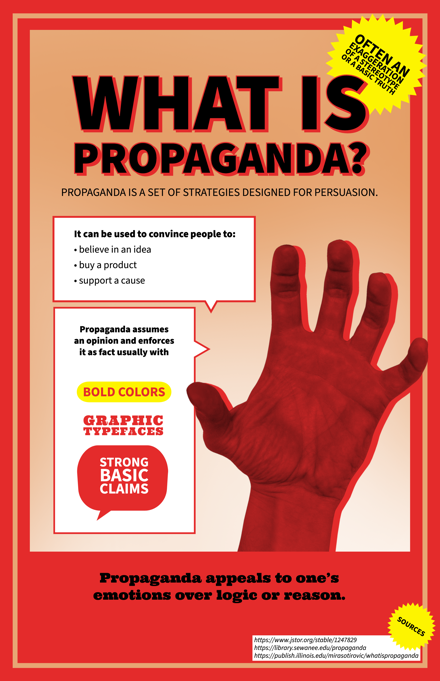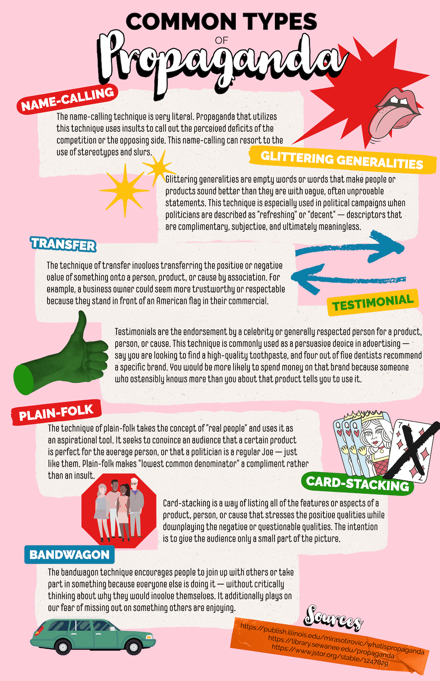The ultimate guide to propaganda

Summary
What is propaganda and how is it used? Learn more about this ancient marketing tool that has influenced civilizations for centuries in this lesson about its techniques, with modern examples of propaganda posters.
What is propaganda?
Propaganda is a set of strategies designed for persuasion. It can be used to convince people to believe in an idea, buy a product, or support a cause. Often an exaggeration of a stereotype or a basic truth, propaganda typically contains information that has been manipulated to influence public opinion.
Propaganda builds upon core ideals that can be already found in a populace. It assumes an opinion and enforces it as fact usually with bold colors, graphic typefaces, and strong basic claims that can be understood and absorbed by a large majority.
In 1939, social scientists Alfred and Elizabeth Lee first classified propaganda as a collection of seven commonly used techniques in their book The Fine Art of Propaganda; those seven techniques were defined as name-calling, glittering generalities, transfer, testimonial, plain-folk, card-stacking, and bandwagon.
The power in each of these categories lies in their appeal to one’s emotions over logic or reason. Each emotion has a strategic advantage to turn a person’s opinion, and that emotion can be preyed upon by a single style of propaganda or multiple employed in tandem.
This free Adobe Express template takes the key points of what propaganda is and layers them against a striking red and black background that evokes feelings of fear and paranoia.

What are common types of propaganda?
Name-calling
The name-calling technique is very literal. Propaganda that utilizes this technique uses insults to call out the perceived deficits of the competition or the opposing side. This name-calling can resort to the use of stereotypes and slurs.
Glittering generalities
Glittering generalities are empty words or words that make people or products sound better than they are with vague, often unprovable statements. This technique is especially used in political campaigns when politicians are described as “refreshing” or “decent” — descriptors that are complimentary, subjective, and ultimately meaningless.
Transfer
The technique of transfer involves transferring the positive or negative value of something onto a person, product, or cause by association. For example, a business owner could seem more trustworthy or respectable because they stand in front of an American flag in their commercial.
Testimonial
Testimonials are the endorsement by a celebrity or generally respected person for a product, person, or cause. This technique is commonly used as a persuasive device in advertising — say you are looking to find a high-quality toothpaste, and four out of five dentists recommend a specific brand. You would be more likely to spend money on that brand because someone who ostensibly knows more than you about that product tells you to use it.
Plain-folk
The technique of plain-folk takes the concept of “real people” and uses it as an aspirational tool. It seeks to convince an audience that a certain product is perfect for the average person, or that a politician is a regular Joe — just like them. Plain-folk makes “lowest common denominator” a compliment rather than an insult.
Card-stacking
Card-stacking is a way of listing all of the features or aspects of a product, person, or cause that stresses the positive qualities while downplaying the negative or questionable qualities. The intention is to give the audience only a small part of the picture.
Bandwagon
The bandwagon technique encourages people to join up with others or take part in something because everyone else is doing it — without critically thinking about why they would involve themselves. It additionally plays on our fear of missing out on something others are enjoying.
This free Adobe Express template pairs a fun color scheme with relatable images within an easy-to-understand infographic format to showcase the most common types of propaganda.

What are key elements of propaganda posters?
Propaganda posters utilize the common types of propaganda to deliver an impactful visual that can be extremely convincing to a larger audience. Typically, an appeal to one’s emotions will be paired with universal symbols or base stereotypes that lead to calls to action on the part of the viewer.
This free Adobe Express template shows how a propaganda poster pulls the viewer in with an image of a young woman with a resolute expression and intense eye contact, evoking feelings of strength, courage, and urgency. This image is coupled with bright and recognizable primary colors, and simple language that addresses the audience directly.

How has propaganda been used throughout history?
Throughout history, propaganda has been created and utilized primarily for political, religious, and advertising purposes. Although the concept of propaganda has existed for centuries, the term itself was popularized around the time of World War II to accentuate the high level of wartime marketing.
Propaganda in the hands of WWII-era dictator and Nazi Party leader Adolf Hitler was used to appeal to base human instincts, economic concerns, and fear of the “other.” An enormous amount of Nazi ideological propaganda was disseminated to reinforce Hitler's personal power and appeal. The Nazi Party used this propaganda to establish both a fervent personality cult around Hitler and a potent national identity that was used to oppress communities that were excluded from this identity. The establishment of this cult and national identity led to mass killing and incarceration of Jews, Roma peoples, and other historically marginalized groups in the name of Hitler.
The term “propaganda” was first coined in 1622 from the organization Congregatio de Propaganda Fide (Congregation for the Propagation of the Faith), established as a campaign by Pope Gregory XV to spread the Catholic faith across “heathen” (non-Catholic) lands. Combining the influence and power of the Catholic Church with the rampant spread of colonialism, this early propaganda was key in unleashing violent oppression across many non-European and non-English-speaking countries through foreign rule emboldened by the Pope’s stamp of approval.
The deliberate effort to sway opinions with persuasive language and imagery in these eras was most visible through advertising. Fear tactics were used by advertisers to drive people towards harmful actions that benefitted politicians and are continually used even now to convince buyers that they need a certain product to avoid a negative outcome.
How to create positive branding in the future
As advertising has evolved and become more realistic and relatable, there are fewer and fewer spaces in which we can be informed rather than persuaded or manipulated. This can make it difficult to separate what’s real from what’s been manufactured to alter your opinion. For this reason, it’s important to be genuine in marketing so people can make their own decisions without untoward influence.
As creatives, business owners, and educators can create positive branding through presenting clear and concise information that is properly cited with multiple sources. Using punchy colors and graphics can still be used to bring in an audience, as long as what you’re presenting is true and useful to a buyer’s journey or an educational process. It can help to ask yourself: does what you’re presenting aid someone in making an informed decision? Are you able to be transparent in your message?
Consumers must also evolve to become propaganda-savvy and aware of the modern market. Knowing these techniques is essential to seeing them at play and side-stepping their influence. It is also important to seek out multiple sources of information, verify facts before making decisions, and feel free to be skeptical of overly emotional appeals.